AFFILIATE MARKETING
Great For Longtail Keyword Research in 2023?

In this vast digital landscape, where millions of websites are competing for attention, one thing remains paramount for success: long-tail keywords. These seemingly small clusters of words have the potential to attract huge amounts of organic traffic, propelling your online presence to new heights.
However, finding the right keywords that resonate with your target audience can be a daunting task, so using the right tools for the job is essential. In this review, we’ll take a closer look at the features KeywordTool.io has to offer.
We’ll explore its user-friendly interface, its ability to generate comprehensive longtail keyword suggestions, and of course, the pros and cons of using this tool.
In the end, we’ll also share some great Keyword Tool alternatives so you can assess all of your options.
So let’s take a look and see exactly why KeywordTool has become so popular.
Keywordtool.io Review
-
Ease of Use
-
Stability
-
Customer Service
-
Price
Summary
Keyword Tool is a great, easy-to-use tool for longtail keyword research. The free version provides useful data, and the paid plans offer additional features like search volume data, but they are expensive for beginners.
Pros
- Easy-to-use
- Get new content ideas
- Easily check search volume in bulk
- Accurate data
- Easier than Google’s keyword planner
- Check keyword data for specific platforms
- Great for YouTube Keyword research
- 30-day money-back guarantee
Cons
- It’s quite expensive
- Competition analysis could be better
- The free version doesn’t include search volume
- Pro basic doesn’t include CPC data
- No free trial on the pro version
- Hard to get support via phone or live chat
As you’ve probably already guessed, KeywordTool.io is a useful tool for anyone looking for longtail keywords. It has a number of practical features, including being able to look at keyword data across a number of platforms, including YouTube, Amazon, and, of course, Google.
This allows you to see what keywords are being used on any of these platforms, how they could relate to you and your brand, and which longtail keywords you should be using within your own SEO campaigns.
These days SEO is about more than just ranking on Google, which is what many people still concentrate on. Instead, by using KeywordTool to research longtail keywords across a number of platforms, you can be sure that your SEO is working for you all over.
There are options to check for keywords in different languages and even different countries. You can also look at keywords for app stores and even Pinterest!
Use their keyword tool to look up search volumes and even keyword interest by region, which means you have easy access to as much keyword data as possible.
KeywordTool.io works by using Google Autocomplete to generate longtail keywords based on your seed keyword.
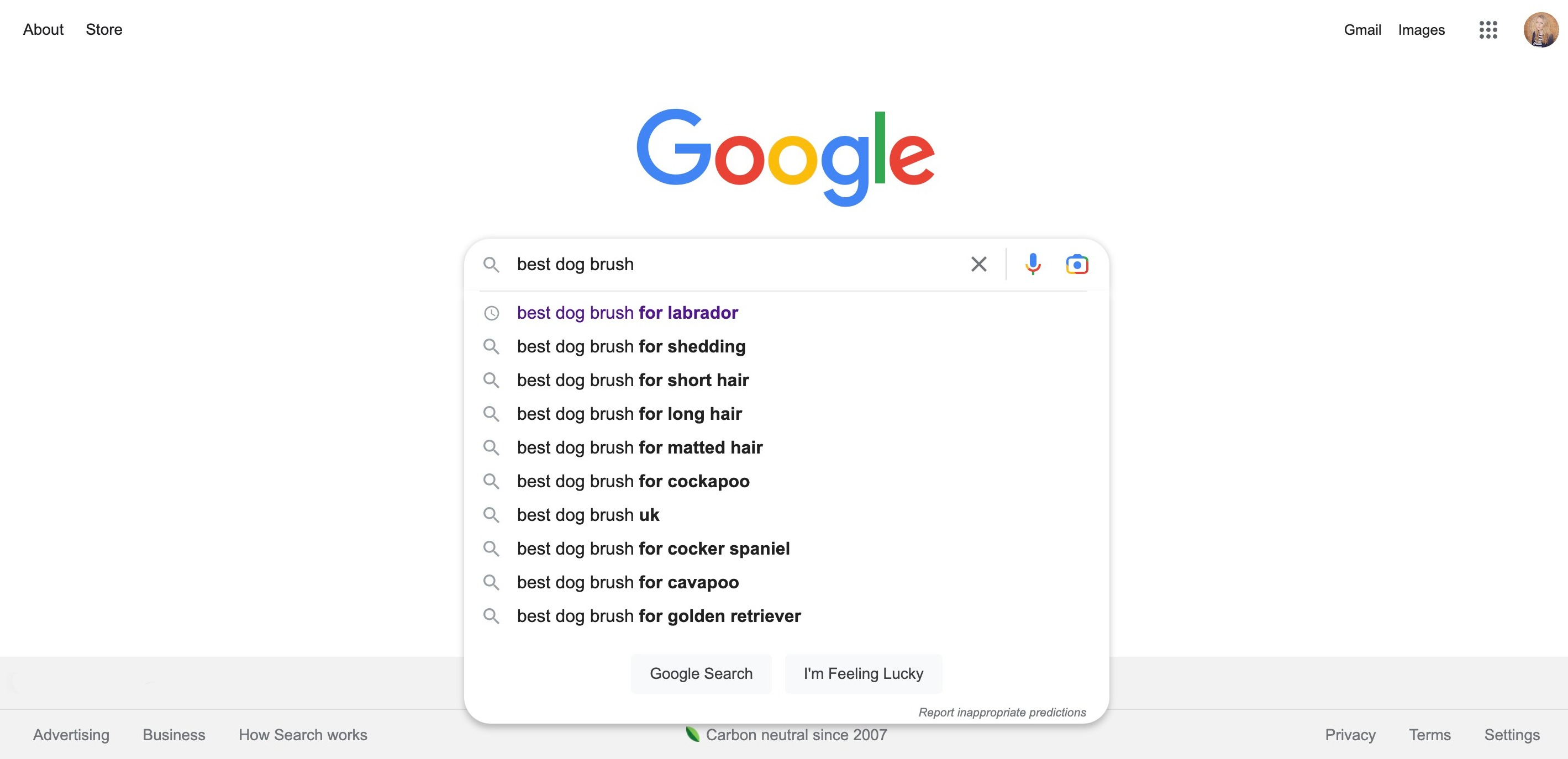
To get started, simply enter a seed keyword, and you will be given hundreds of relevant keyword suggestions.

You can then sort through these, filter them, and remove any negative keywords to get a list of the most relevant keywords.

The free version will generate up to 750 results per search in just a few seconds. If you want to view more data on these keywords, such as the search volumes or the CPC data, you can sign up for Keyword Tool Pro.
The Pro version gives you up to twice as many keywords for every search, along with lots of other useful data that you can use to find the most profitable keywords for your campaign.
This includes:
- Search volume
- Trends
- Average CPC
- Competition
One of the recurring themes within KeywordTool.io reviews is how easy it is to use. This is great news for those that are new to longtail keyword research.
With options to do things like export keyword data and analyze it even further, it’s a great tool for getting to grips with keyword research and what keywords you should be using if you want your SEO efforts to be successful.
Not only that but being able to analyze what keywords your competitors are doing and what is working for them means that you have a powerful tool in your armory to help you stay ahead of the competition.
You can use Keyword Tool Pro to discover what keywords you should be used within blog posts, how to create relevant content for your social media campaigns, and even how you should be targeting your Google ads to ensure that they work for you as efficiently as possible.
KeywordTool.io has some amazing free features, and for many people, these free tools will be enough for them to get started.
However, if you are someone that needs more or wants to expand their SEO efforts, then you’ll be pleased to know that the Pro version of KeywordTool.io has a number of extra features for you to take advantage of.
For example, you’re able to look up twice as many keywords as you can on the free version. This is ideal for larger SEO campaigns and those that want a bit more information.
With the pro version, you’re able to look up 100% accurate search volume information for both Google and Bing.
On top of that, you can look at the level of competition you’re facing on Google ads. This means you can get hints on suggested bids and even tweak your own advert.
This will ensure that you reach as many people as possible. Once you have keywords put together, you can get search volume data and/or export all of your findings to Excel so you can analyze them offline or share with others.
As you might imagine, with any too like this, there are going to be both pros and cons. These include:
Pros:
- Easy-to-use
- Get new content ideas
- Easily check search volume in bulk
- Accurate data
- Easier than Google’s keyword planner
- Check keyword data for specific platforms
- Great for YouTube Keyword research
- 30-day money-back guarantee
Cons:
- It’s quite expensive
- Competition analysis could be better
- The free version doesn’t include search volume
- Pro basic doesn’t include CPC data
- No free trial on the pro version
- Hard to get support via phone or live chat
Keyword Tool is useful to anyone with a website, blog, or online business that wants to attract organic traffic. The easy-to-use interface means that even those doing SEO keyword research for the first time should find it easy to get the information they need.
However, it’s worth keeping in mind that it isn’t an all-in-one tool. If you need additional features like backlink analysis you may need to invest in other tools later down the line on your SEO journey.
KeywordTool is also a very useful tool for YouTubers. Users can quickly and easily create a list of long-tail keywords from YouTube data. They can then use the best keywords as a starting point to create videos designed to attract views.
As you might imagine, the free tool does have some limitations, although there is, of course, the option to upgrade to any of the pro versions.
That said, the free version is perfect for those that what basic keyword research, perhaps just for a small campaign or because they are new to SEO keyword research and want to see what they are getting into before they delve too deep.
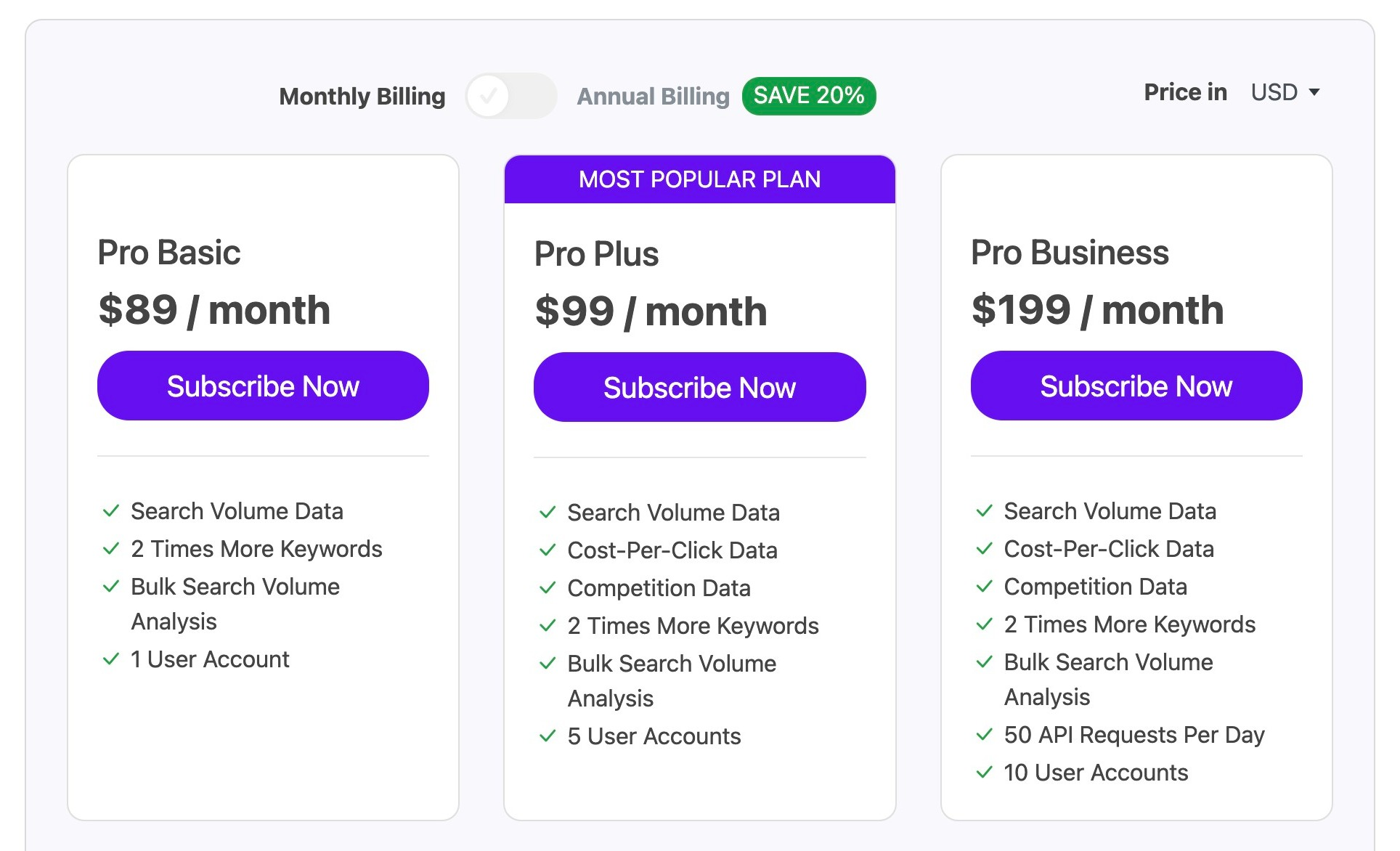
Pro Basic. $89/month (discounted if you pay annually). Access to search volume data, extra keyword data compared to the free version, search volume analysis of 10,000 keywords a day, and one user account.
Pro Plus. $99 per month (discounted if you pay annually). As above, with 50,000 keywords a day and 5 user accounts. Also, access to cost-per-click data, Google ads competition data, and API requests.
Pro Business. $199 per month (discounted if you pay annually). As above, with 1000,000 keywords a day and ten user accounts.
Each subscription has a 30-day money-back guarantee, so you can email them within the first month for a refund if you’re unhappy.
The Bottom Line
The free version of Keyword Tool is a great option for anyone looking to get longtail keyword ideas. If you need more data like search volumes, you will need to upgrade to a paid plan—and the plans aren’t cheap, particularly if you’re just starting out.
That said, for those that are looking for simple-to-read data when it comes to longtail keyword research, it is a great tool. It’s super easy to use, with easy-to-read data and an interface that has clearly been designed with the user in mind.
Of course, KeywordTool.io isn’t the only way to do your keyword research, so it’s important to look into all of the tools available and pick the right one for you. Here are some of the best KeywordTool.io alternatives worth checking out.
KeySearch
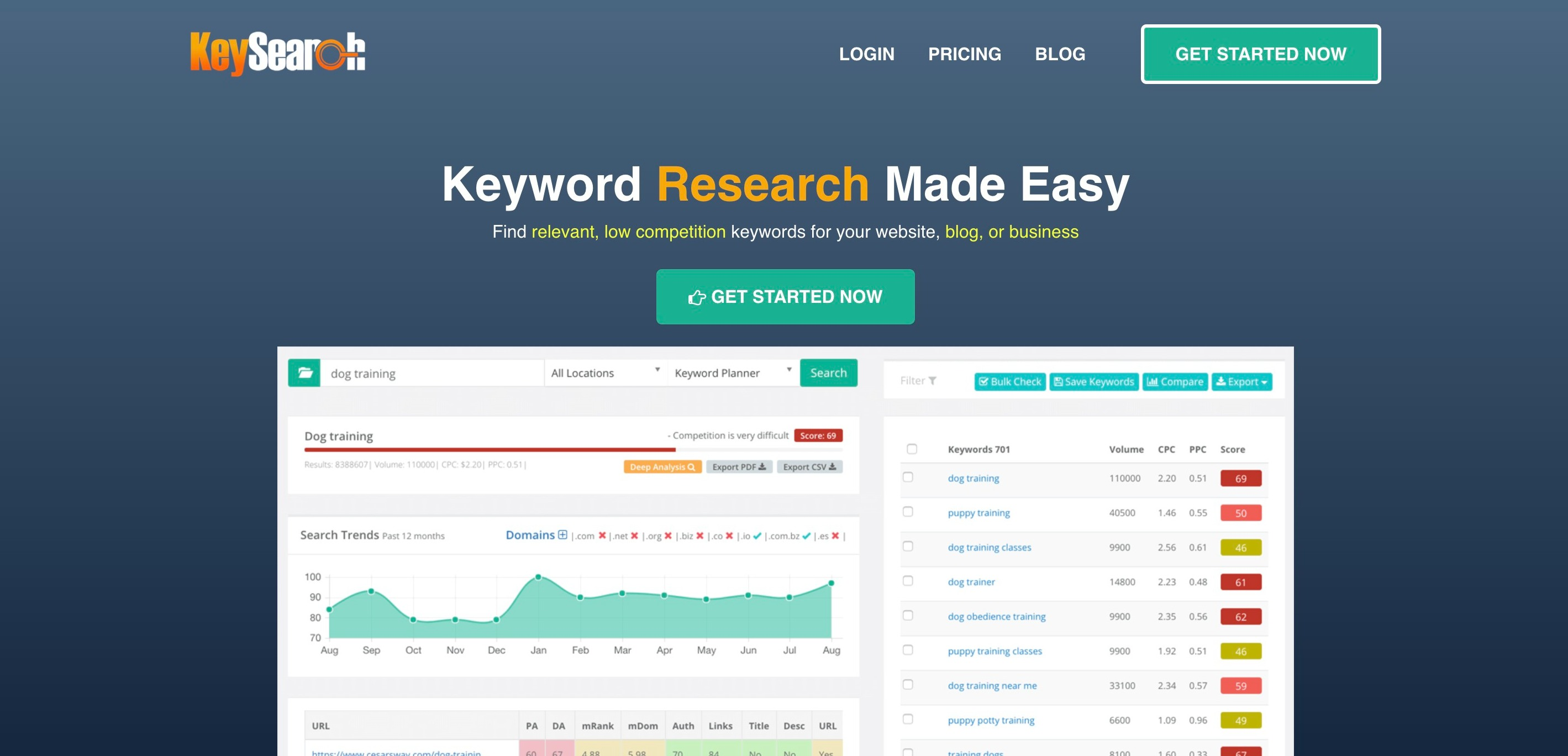
Keysearch is a popular choice for those that are looking for easy keyword research at an affordable monthly price. It’s well-known for being super user-friendly, and it’s a great option for finding long-tail keywords.
It also has loads of other great features like backlink analysis, competitor gap, and a content assistant to make sure you outrank your competitors. Check out my Keysearch Review to find out more about this awesome tool!
Use coupon code KSDISC for 20% OFF
Low Fruits
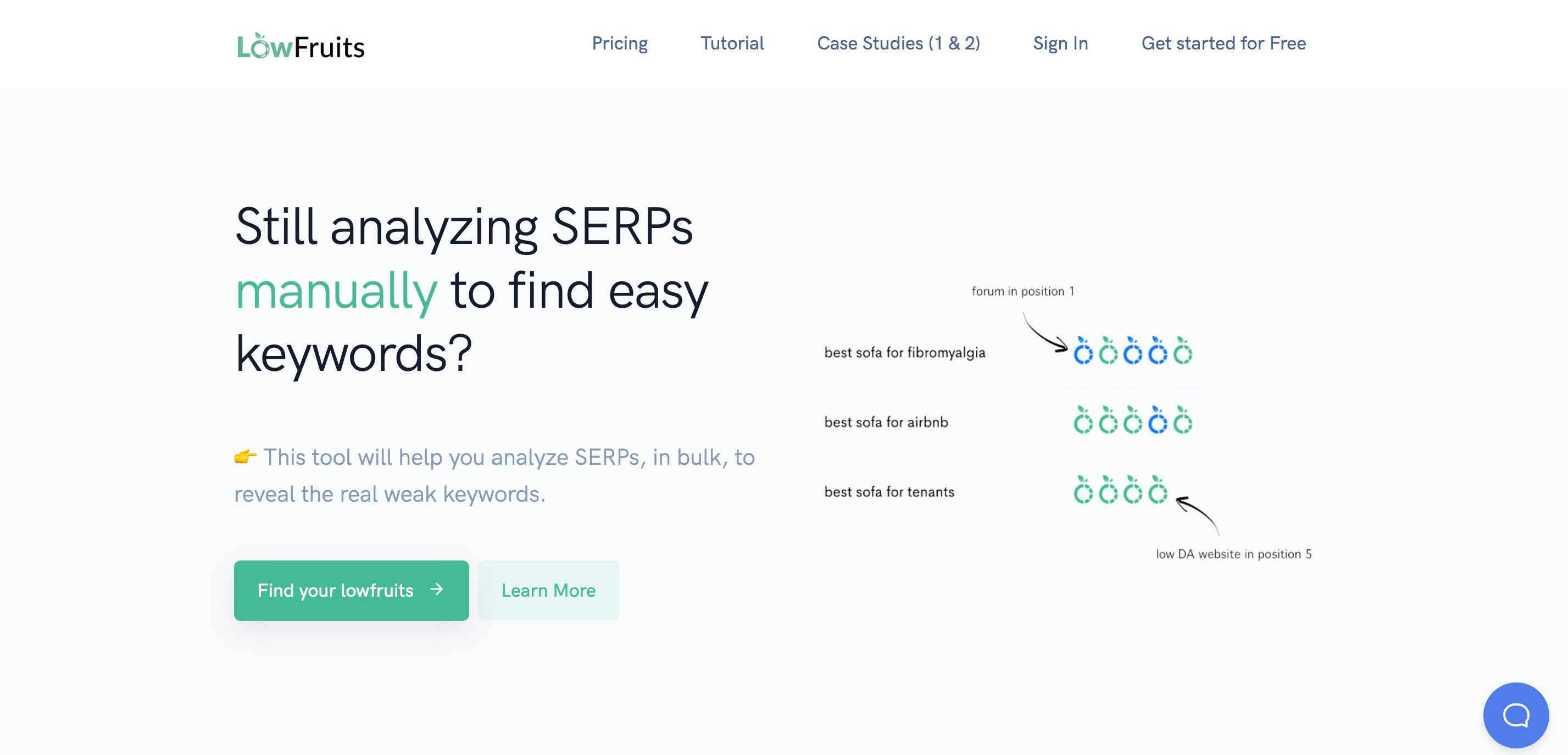
Low Fruits is a goldmine for anyone looking for low-competition longtail keywords. It’s great for finding keyword clusters, and it shows you the competition for every keyword so that you can find the ‘low hanging fruits’.
Best of all, it’s incredibly affordable, starting at just $25 for 2000 credits, so it’s suitable for publishers of all sizes and budgets.
Keyword Chef
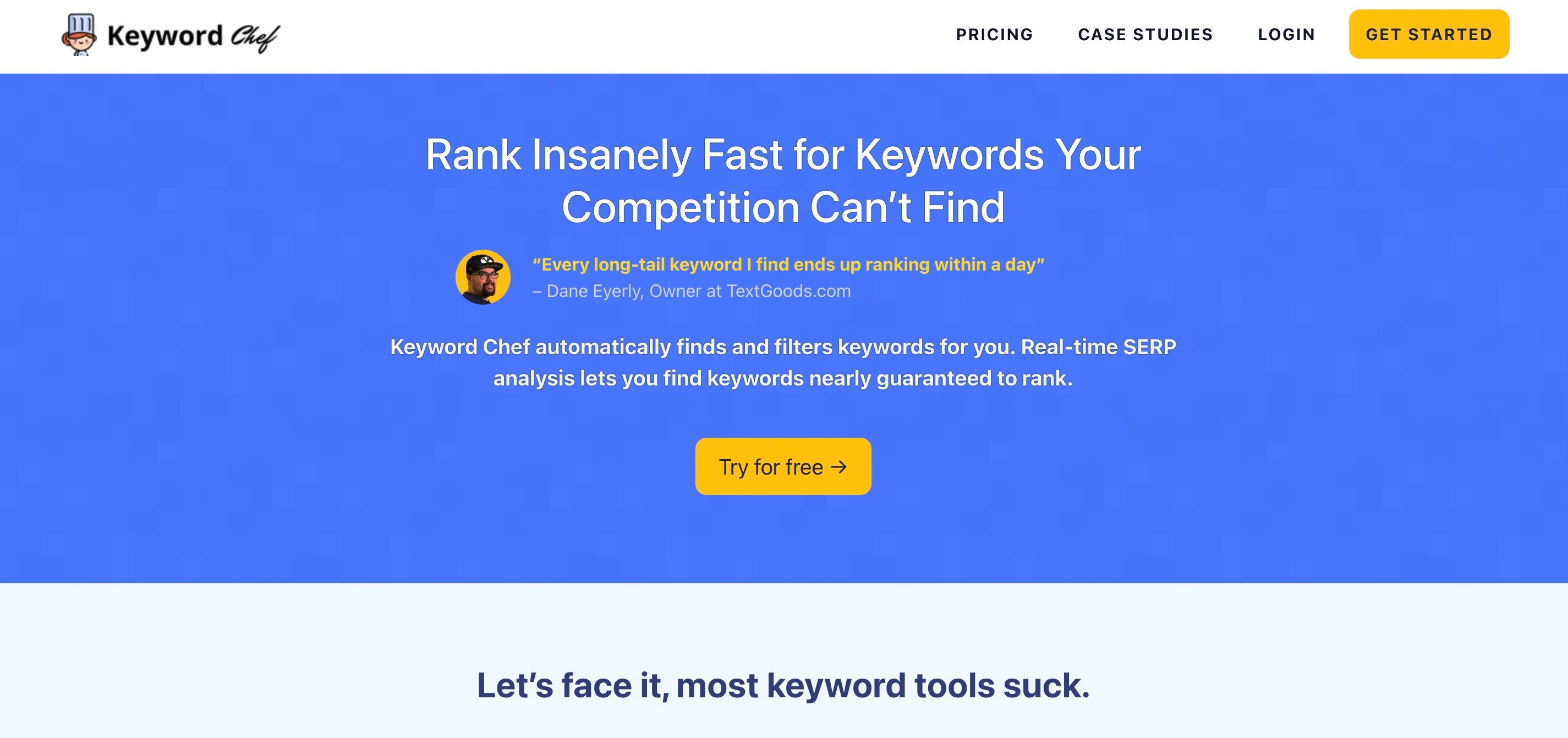
Keyword Chef is another fantastic option for finding longtail keywords. It has a try-for-free option, which allows you to get started with keyword research and ensure this is the right tool for you before you commit.
Keyword Chef has a range of tools and features, including automatically finding and filtering keywords for search intent, making your keyword research process as easy as possible. Our full Keyword Chef review has more info.
AFFILIATE MARKETING
AI Marketing vs. Human Expertise: Who Wins the Battle and Who Wins the War?

Opinions expressed by Entrepreneur contributors are their own.
Uncover the truth about AI in marketing and why it’s a ticking time bomb for unprepared businesses! As AI revolutionizes the marketing landscape, understanding its long-term impact is crucial.
In this video, I dive deep into the reality of AI marketing, exposing the myths and revealing strategies to stay ahead of the curve. Learn why AI might play in your favor for the next 3 years, but could spell trouble if you’re not prepared for what’s coming. Discover how to leverage AI tools effectively while developing a future-sighted approach that will keep you competitive in an AI-driven world.
Download the free ‘AI Success Kit‘ (limited time only). And you’ll also get a free chapter from Ben’s brand new book, ‘The Wolf is at The Door – How to Survive and Thrive in an AI-Driven World.’
AFFILIATE MARKETING
5 Financial Blind Spots That Could Be Preventing You From Making More Money

Opinions expressed by Entrepreneur contributors are their own.
Money can often be the barrier between being stuck where you are or breaking through to the next level. This includes having or not having a budget, using it properly, hidden revenue or even misaligned goals — all of which influence your growth trajectory. These four common secrets have helped my company elevate our clients to the next level.
1. Financial transparency for ROI
The first blindspot we often notice with new clients is not having a clear reporting connection between your tools, like ads and a CRM like HubSpot, to see which channels drive the most significant return on investment (ROI). Do you know your best-performing channels? Or your best-performing piece of sales copy? What is the most opened document that leads to a closed deal?
And we’re not just talking about marketing and sales; this applies to many connected platforms — for example, the closed-loop revenue or your ERP systems. When things are not connected, they are disjointed and siloed. You end up flying blind. Without connecting your marketing tools with your revenue tools, and with that being CRMs, finance platforms, or ERPs, to name a few, there is a disconnect, and the arms and legs end up moving in different directions.
Here’s a simple example we see all the time: If you knew that one channel drove more deals by a 75% faster conversion rate, wouldn’t you invest more time and energy in that channel than one that only had a conversion rate of 10%? Many people don’t want to share the revenue numbers within the company, but all of that information informs the other departments; without sharing these revenue numbers, your money secret is keeping it in hidden silos.
2. Strategic investment for avoiding blind spots
Another financial blindspot is not investing in marketing. We have had prospects come in with no budget and no internal marketing team, but we want to grow by 150% and spend a total of $1,000. I wish achieving growth like this was possible, but unfortunately, it’s not. The old adage that you get what you pay for, or it takes money to make money, speaks the truth. Your investment goals should match your growth goals. The amount of money invested should be measured not just by short-term, quick wins but also by looking at long-term investment to growth.
You would never measure an HR department strictly on the number of hires. However, looking at the whole picture of longevity amongst many other important KPIs, You would not use an HR department for a few months. It is something that is constant and needs care and attention. Marketing is no different — if you strictly only measure marketing by the number of leads, you are missing out on the full picture. Marketing helps push leads through nurture campaigns, creates automation, leads scoring, builds new campaigns and tests, supports sales enablement activities and many other components. A buying cycle is rarely a straight line to click and buy unless we’re discussing Amazon.
That said, everyone has budgets, margins and bumper lanes they need to stay in. I am by no means saying throw your budget to the wind, but your goal should match your budget. If you have modest growth goals, be realistic about the budget needed to get there. Set incremental micro goals but stay the course for long-term growth.
Related: You Won’t Have a Strong Budget Until You Follow These 5 Tips
3. Data-driven decisions to save money
Another money secret that costs companies is spending without the data to back it. We had a company inquire about a new website, a full blow-up, new navigation, new content, new page layouts, migration onto a new CMS, a new theme and the works. They said they had a $75,000 budget for the whole project. In theory, it sounds great, right? Willing to invest? Check. Has a budget? Check. Know what they want the end result to be? Check. But when we asked them the next question, they looked at us like we were crazy, “Do you have data that backs the changes you are looking to make?” Are you running a tool like Hotjar to see real user data behind how these proposed changes will impact your existing inquiries and the only source the sales team was currently using for leads?
The answer was no. When the heat map was overlaid, do you know what happened? Well, they were looking to build that new navigation out and replace the old one — nearly 90% of the traffic was going to two pages of their site directly from the navigation, both of which they had originally wanted to remove. In this case, it wasn’t just about having the money but also about making sure the decisions you make with the budget are informed by real data: user data, sales data, marketing data and more. The more informed you can be by closing the loop on your data, the better your end result will be.
Related: Want to Be Better at Decision Making? Here are 5 Steps to Better Data-Driven Business Decisions
4. Modern marketing channels to drive growth
What is likely costing you the most is using old-school channels without the ability to measure. Companies have spent the last decade on traditional marketing channels and are switching to digital. The company’s historical growth has relied on things like trade shows, print, postcards and online magazines. We ask what the ROI you have seen by each channel is, and rarely can they share a specific revenue number and say it is for brand awareness. Some of the budgets can be over 50 to 100 thousand dollars spent on these traditional methods, but there is no ROI attached, yet they continue them.
When the pandemic happened, we saw a massive influx in businesses shifting from once only boots on the ground to digital. The lockdown changed everything; there were no more trade shows, no more door knocking and no one picking up their mail or faxes daily. It made traditional selling channels challenging and obsolete and forced a new level of openness to try new ways to get the job done. In the example of running online magazine ads there are lots of ways to capture them, we can use UTM tracking, referral analysis or create a custom landing page for the offer and capture the leads directly. Without running them to a landing page or form, you rely only on the online publication for leads and analytics. We’ve had people show a list of just names, no emails to follow up with, or only show a random number of visitors to the page, not a single name. It’s important to know what they will provide for reporting and tracking when you publish or use traditional channels. The rule of thumb is to use connections and tools that leverage old-school methods into technology and not blindly spend on channels that cannot be measured.
Stop wasting time, energy and revenue on these blind spots. They have easy solutions, so you can avoid them and focus on growing your business!
AFFILIATE MARKETING
How Nvidia Pivoted From Graphics Card Maker to AI Chip Giant

A decade ago, Nvidia was a major graphics card maker, vying with competitors like AMD and Intel for dominance. Now it’s an AI giant with 70% to 95% of the market share for AI chips, and the brains of OpenAI’s ChatGPT. It’s also the best-performing stock with the highest return in the past 25 years.
Why did Nvidia invest in AI chips over 10 years ago, ahead of the competition? CEO Jensen Huang and board member Mark Stevens, Nvidia’s two largest individual shareholders, talked to Sequoia Capital partner Roelof Botha to explain what Botha called “one of the most remarkable business pivots in history.”
Nvidia’s original product was 3D graphics cards for PC games, but company leaders noticed by the mid-2000s that the PC market was hitting a growth limit.
“We felt we were always gonna be boxed into the PC gaming market and always knocking heads with Intel if we didn’t develop a brand new market that nobody else was in,” Stevens explained.
Jensen Huang, co-founder and chief executive officer of Nvidia. Photographer: Lionel Ng/Bloomberg via Getty Images
That need for a new market intersected with a product Nvidia already had on hand: its graphics processor unit, or GPU, which could be used to power tasks outside of gaming. Researchers at universities across the world began exploring the graphics cards, eventually building advanced computers with them.
Related: Is It Too Late to Buy Nvidia? Former Morgan Stanley Strategist Says ‘Buy High, Sell Higher.’
Huang recalled meeting a quantum chemist in Taiwan who showed him a closet with a “giant array” of Nvidia’s GPUs on its shelves; house fans were rotating to keep the system cool.
“He said, ‘I built my own personal supercomputer.’ And he said to me that because of our work… he’s able to do his work in his lifetime,” Huang said.
Other researchers, like Meta AI chief Yann LeCun in New York, began reaching out to Nvidia about the computing power of its chips. Nvidia began considering the AI market when AI had yet to enter the mainstream and was a “zero billion dollar market” or a market that had yet to materialize.
“There was no guarantee that AI would ever really emerge because, keep in mind, AI had had many stops and starts over the last 40 years,” Stevens said. “I mean, AI has been around as a computer science concept for decades. But it had never really taken off as a huge market opportunity.”
Huang and other company leaders still believed in AI and decided to invest billions in the tech in the 2010s.
“This was a giant pivot for our company,” Huang said. “The company’s focus was steered away from its core business.”
Huang highlighted the extra cost, talent, and skills Nvidia had to account for with the pivot, as it affected the entire company. It took 10 to 15 years of effort, but that business decision led to Nvidia powering the AI revolution with an early ChatGPT partnership.
“Every CEO’s job is supposed to look around corners,” Huang said. “You want to be the person who believes the company can achieve more than the company believes it can.”
Related: How to Be a Billionaire By 25, According to a College Dropout Turned CEO Worth $1.6 Billion
-

 SEARCHENGINES6 days ago
SEARCHENGINES6 days agoBillions Of Google goo.gl URLs To 404 In The Future
-
SEARCHENGINES5 days ago
Daily Search Forum Recap: July 22, 2024
-

 SEO6 days ago
SEO6 days ago11 Copyscape Alternatives To Check Plagiarism
-

 SEARCHENGINES7 days ago
SEARCHENGINES7 days agoGoogle Core Update Coming, Ranking Volatility, Bye Search Notes, AI Overviews, Ads & More
-

 SEO6 days ago
SEO6 days agoGoogle Warns Of Last Chance To Export Notes Search Data
-
SEARCHENGINES4 days ago
Daily Search Forum Recap: July 23, 2024
-

 AFFILIATE MARKETING6 days ago
AFFILIATE MARKETING6 days agoThe Top 5 AI Tools That Can Revolutionize Your Workflow and Boost Productivity
-

 SEO4 days ago
SEO4 days agoSystem Builders – How AI Changes The Work Of SEO















